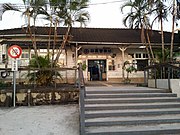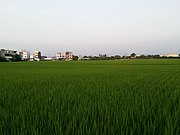Liujia (Tainan)
|
Liujia 六甲 區 |
||
 Location of Liujia in Tainan |
||
| State : |
|
|
| Coordinates : | 23 ° 13 ' N , 120 ° 23' E | |
| Height : | 15 - 249 m | |
| Area : | 67.5471 km² | |
| Residents : | 22,148 (Dec 2018) | |
| Population density : | 328 inhabitants per km² | |
| Time zone : | UTC + 8 (Chungyuan time) | |
| Telephone code : | (+886) (0) 6 | |
| Postal code : | 734 | |
| ISO 3166-2 : | TW-TNN | |
| Community type : | Municipality of Tainan | |
| Structure : | 11 districts ( 里 , Lǐ ) | |
| Website : | ||
|
|
||
Liujia or Lioujia ( Chinese 六甲 區 , Pinyin Liùjiǎ Qū , Tongyong Pinyin Liòujiǎ Cyu , W.-G. Liu 4 -chia 3 Ch'ü 1 , Pe̍h-ōe-jī La̍k-kah-khu ) is a district of the government - immediate city of Tainan in the southwest of the Republic of China on Taiwan .
Location and description
Liujia is located north-central in the urban area of Tainan. The district has the shape of a lying rectangle with the edge lengths 3–4 × 18 km. In the west, the district is part of the Jianan Plain , a fertile alluvial plain . In the east the terrain is more mountainous and already shaped by the foothills of the central mountains .
history
According to legendary tradition, the land of today's Liujia was first cultivated at the time of Zheng Chenggong in the 17th century. Followers of Zheng settled here as farmers and divided the land according to the Jia ( 甲 , a Taiwanese measure of area). This is how the names Erjia ( 二甲 - "two Jia"), Liujia ( 六甲 - "six Jia"), and Qijia ( 七 甲 - "seven Jia") came about . Later the name Liujia was transferred to the whole locality. The first permanent Han Chinese settlers came from the Chinese mainland from the coastal province of Fujian . During the Qing reign, Liujia was part of Zhuluo ( 諸 羅 ) County . During the time of the Japanese rule (1895-1945) various administrative reorganizations took place and from October 1, 1920, Liujia was a community in Tainan Prefecture . After Taiwan was taken over by the Republic of China in 1945, Liujia became a rural community in the newly established Tainan County and, after the county was incorporated into the city of Tainan, on December 25, 2010, it became a municipality in Tainan.
population
With around 22,000 inhabitants, Lujia is one of the districts with a rather smaller population in Tainan. Members of indigenous peoples make up only a very small proportion of the population (less than 0.5%).
| Outline of Liujia |

|
Administrative division
Liuying is in 13 districts ( 里 , Lǐ divided).
1. Jingpu ( 菁 埔里 )
2. Guigang ( 龜 港 里 )
3. Zhongshe ( 中 社 里 )
4. Shuilin ( 水 林 里 )
5. Erjia ( 二甲 里 )
6. Qijia ( 七 甲 里 )
7. Liujia ( 六甲 里 )
8. Jianan ( 甲 南 里 )
9. Jiadong ( 甲 東 里 )
10. Wangye ( 王爺 里 )
11. Daqiu ( 大 丘 里 )
traffic
The larger roads mostly run in a north-south direction. These are the national road 3 (highway) in the center and largely parallel to it the county road 165, as well as the provincial road 1 in the western part and the county road 174 on the east edge.The latter turns north of Liujia to the west and then runs over a longer distance through the district in East-West direction.
economy
Agriculture is the dominant industry in Liujia. In the plains in the west, rice cultivation and the culture of specialties such as cultivated mushrooms and "Chinese olives" (the fruits of the "white canary tree" Canarium album ) predominate . In the mountainous east bamboo is mainly grown (varieties Phyllostachys makinoi , "Makino bamboo" and Bambusa blumeana , "thorn bamboo"). The fruit production includes oranges (about 15,000 tons to about 500 ha) and longans (about 3670 t to 370 ha). The latter are mainly grown in Wangye and Daqiu. The horticulture ( flamingo flowers ) is carried out on about 20 hectares. Fish farming ( tilapia , 吳 郭 魚 , Wúguō yú ) plays a certain role and pigs, dairy cattle and sheep are kept on farm animals.
In addition to agriculture, there is an old, small-scale tradition of pottery and ceramics that goes back to the time of Dutch colonial rule . Red ceramics were and are made from the local clay soil .
Special features and tourist destinations
The Chihshan Longhu Temple ( 赤山 龍湖 巌 , Chìshān lónghú yán ) is worth seeing . The temple has a history of more than 300 years, but has been rebuilt many times. Every year around February 19, festivities are held here in honor of Gautama Buddha . The Wushantou reservoir , which is also known as the Coral Lake ( 珊瑚潭 ), is located partly in the area of Liujia . The dam was planned and built from the 1920s by the Japanese couple of engineers Yoichi Hatta ( 八 田 ab 一 ), which is reminiscent of a small memorial.
The South Campus of the Research Institute of Industrial Technology (ITRI) is located in Liujia , with its headquarters in Hsinchu . The facilities opened on October 14, 2005.
Web links
Individual evidence
- ↑ Natural Environment. Liujia's website, accessed March 2, 2019 .
- ^ History. Liujia's website, accessed March 2, 2019 .
- ↑ 原住民 戶數 及 人數 Households and Persons of Indigenous People. (xls) Taiwan Ministry of the Interior, accessed May 5, 2018 (Chinese, English).
- ↑ a b Industry Profile. Liujia's website, accessed March 2, 2019 .
- ↑ Chihshan Longhu Temple. Liujia's website, accessed March 2, 2019 .
- ^ Coral Lake, Honoring Yoichi. Liujia's website, accessed March 2, 2019 .
- ^ Industrial Technology Research Institute southern branch campus. Liujia's website, accessed March 2, 2019 .



